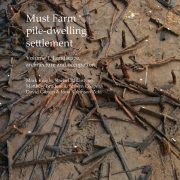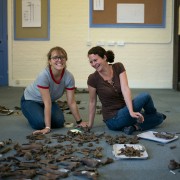Overview
The Must Farm Late Bronze Age pile-dwelling settlement consisted of stilted roundhouses built above a river channel and surrounded by a palisade of sharpened stakes. It was occupied for just nine months to a year before a catastrophic blaze destroyed it, with the fire tearing quickly through the structures, causing the houses’ contents to fall into the muddy river below. It was this perfect combination of charring and waterlogging that caused thousands of objects to survive including almost 200 wooden artefacts, over 150 fibre and textile items, 128 pottery vessels and more than 90 pieces of metalwork.
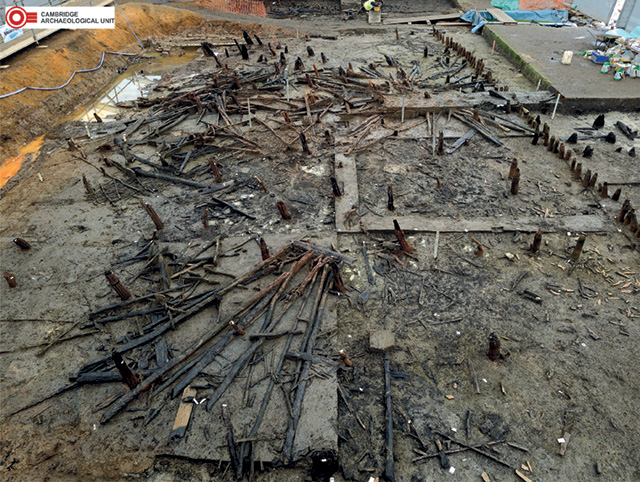
Must Farm’s Material
The Must Farm settlement has produced the largest assemblage of domestic material ever recovered from a Late Bronze Age site in the UK. Critically, it is the circumstances of the site’s destruction by fire that captured a moment in time and allowed archaeologists to see inside the homes of the people living c.850BC.
As the buildings burned their flexible floors, constructed from woven roundwood panels, collapsed causing their contents to drop into the river beneath. Environmental analysis has shown that the river below was relatively shallow, slow moving and full of vegetation. This vegetation would have helped cushion the material falling from the structures, preventing damage, before the artefacts came to rest at the bottom of the channel. The very slow flow of the water meant that the items landed, and remained, directly underneath where they had originally been stored and used inside the houses. This meant all the buildings’ contents mirrored their actual positions within a Bronze Age home, allowing archaeologists to understand how space in these roundhouses was used.
While there were some slight variations between roundhouses, Structure 1 had distinctive “zoning” of activities, suggesting specific uses of the internal space comparable with the rooms we have in houses today. To the northwest complete pots and wooden containers suggest a kitchen or cooking area with metal tools appearing to have been stored in the eastern side of the roundhouse. The presence of textiles and bundles of fibres in the southeast of Structure 1 suggests work on these materials occurred here. This location may have been chosen as it was close to an entranceway where the most light would have entered the houses. Spinning appears to have happened in Structures 2, 3 and 5 with these roundhouses supplying yarn to Structure 1.
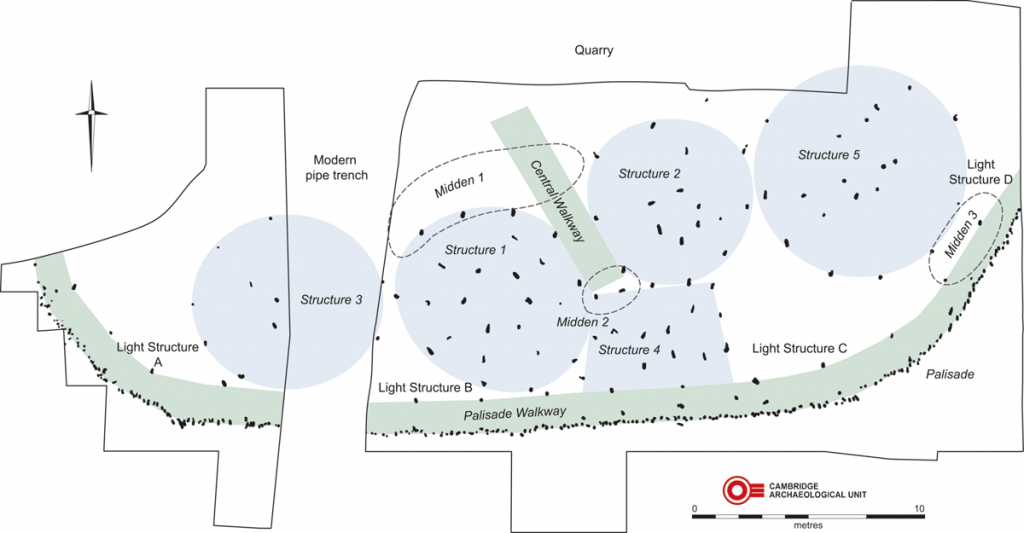
In the southwest, articulated lamb remains and charred droppings were discovered indicating that young sheep were kept inside the homes. While there is no evidence that any of the people residing at the settlement died during the fire, the lambs appear to have been trapped inside the structures. The largely empty spaces in the structures’ northwest areas are thought to have been used as a sleeping area where associated features, including possible wooden furniture and animal skins or bedding did not survive.
Around the exterior of the roundhouses we discovered middens of waste material that had accumulated during the short time the settlement was occupied. These halos of rubbish included broken pots, butchered animal bone and coprolites and create a neat distinction between refuse dumped outside and the “living” household inventories deposited underneath the roundhouses when they were destroyed. That the conditions of the Must Farm settlement’s destruction also preserved the arrangement and storage of artefacts within their structures is extremely rare and not only allows us to find out how space inside Bronze Age homes was used but also what an everyday house from this time would have contained.
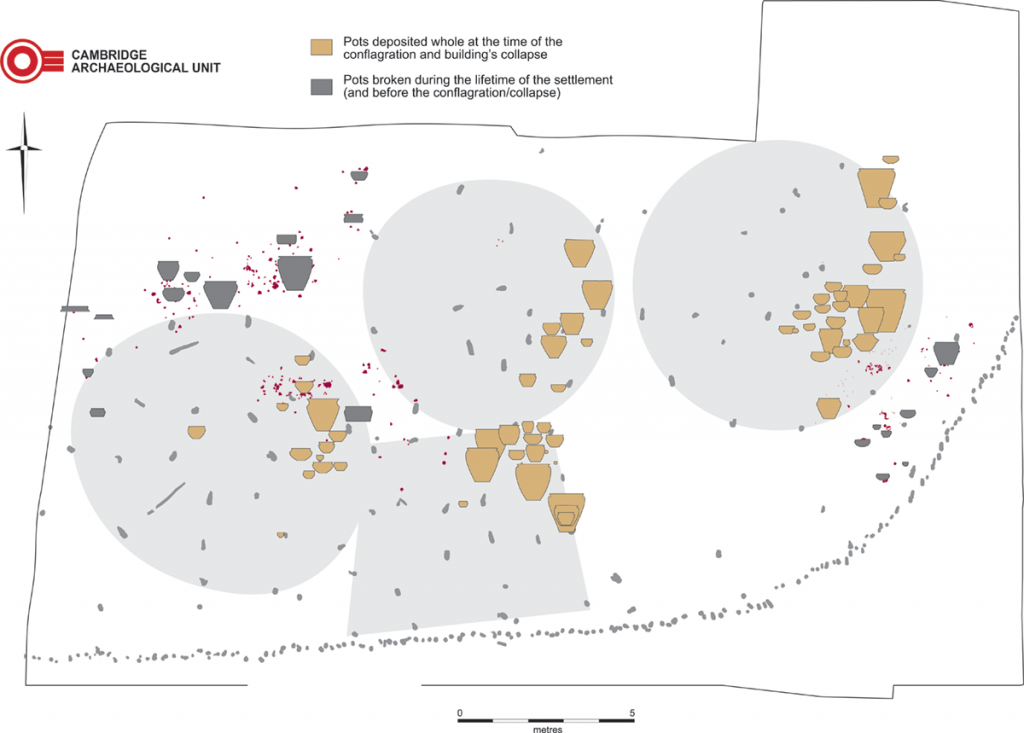
Inventories and Storage
Most artefacts recovered from the Bronze Age, particularly metalwork, do not come from domestic contexts in the UK. Finding an assemblage of material, especially one so large and complete, that reflects the everyday contents of a lived-in house, allows archaeologists to compare the inventories of the different homes in the Must Farm settlement. While there is some variation across the structures there is a remarkable degree of consistency, helping us to understand what material would have been present in a Bronze Age house and in what quantities.
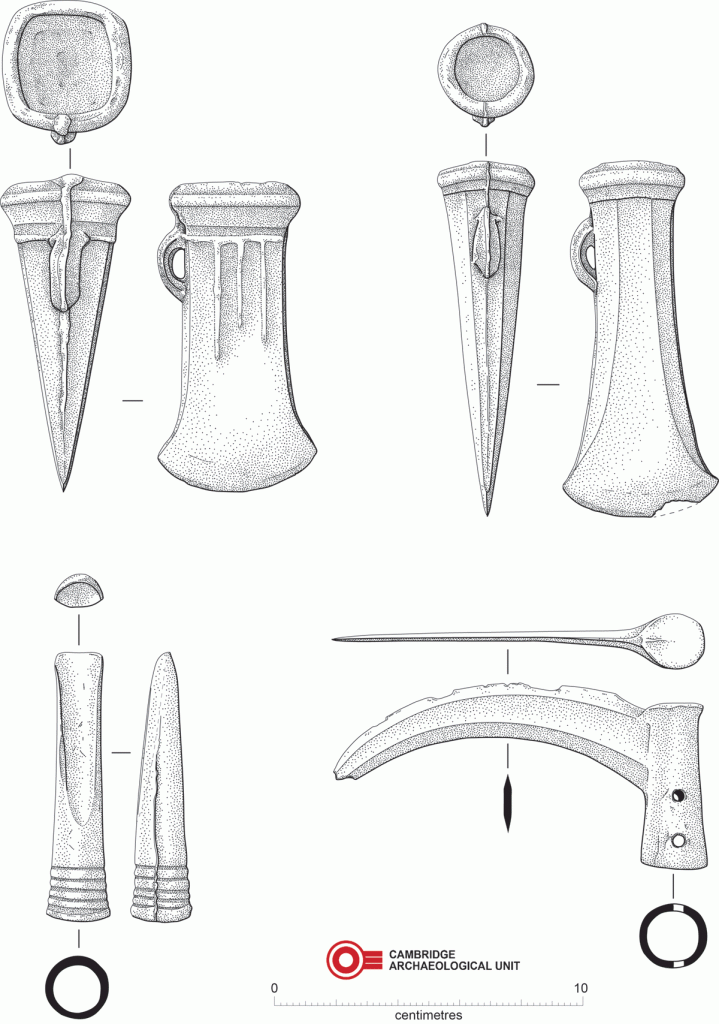
A Must Farm house would have contained a metalwork “tool kit” featuring several hafted socketed axes, sickles, gouges and razors. Homes were also clearly spaces for textile production with loom weights, spindle whorls, bobbins of thread and bundles of fibre being present in most roundhouses. Each structure also had a rich variety of vessels, both ceramic and wooden, in a range of different sizes and styles including tiny cups, fineware bowls and large storage jars. Some pots were even designed to stack inside one another to save space.
One of the site’s buildings, the square-shaped Structure 4, is slightly different from the stilted roundhouses. Evidence suggests this could have been an entrance into the settlement, as it is located next to the palisade and the riverbank. Structure 4 also appears to have been used as storage for the settlement with objects being kept here or waiting to be taken away from the site. One of the building’s finds included a wooden bucket of broken bronze tools and weapons that had been gathered together ready for being melted down and recycled.
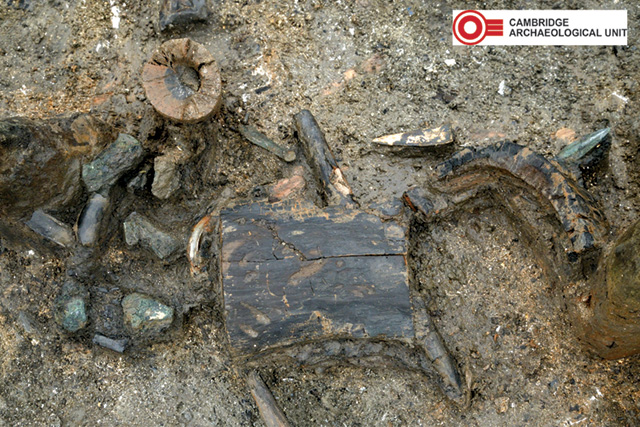
Everyday Life
The archaeology at Must Farm gives us an unparalleled insight into the arrangement and contents of these Late Bronze Age homes but also allows us to understand some amazing details of everyday life during the period. One of the most incredible discoveries was a coarseware pottery bowl, with the finger marks of its maker captured in its clay, that still contained its meal at the time of the site’s destruction. Consisting of a wheatmeal porridge mixed with animal fats, potentially from a sheep, goat or red deer, the meal still contained the wooden spatula used for stirring resting against the inside of the bowl.
Evocative traces of the settlement’s inhabitants, that give archaeologists an insight into their lives, were visible across the site. The base of a wooden bucket shows the cut marks left behind when someone turned it upside and used it as an impromptu chopping board. A tiny, charred ball of thread, its strands half a millimetre thick and made from flax, survived for nearly 3,000 years and is still instantly recognisable. A necklace, consisting of beads made from glass, amber, siltstone and shale was present inside one of the structures at the time of the fire. Indeed, decorative beads were found across the site and all but one of Must Farm’s 49 glass beads may have been made in Iran, 4,500k away.
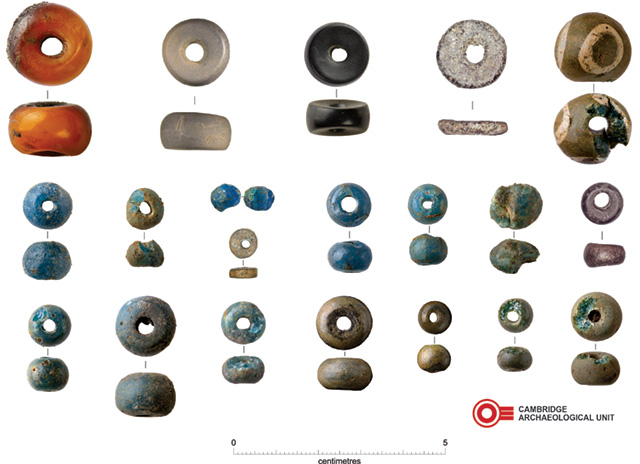
Bronze Age Architecture
When archaeologists in the UK typically encounter the remains of dryland Bronze Age houses all that remains are postholes. At Must Farm the preservation meant that an astonishing 18,021 pieces of structural wood were recorded. The excellent survival of so much of the timber used to construct the settlement provides archaeologists with an extraordinary degree of insight into the buildings’ architecture.
The fire not only helped to preserve much of the wooden superstructure, by creating a charred outer surface resistant to decay, it also created distinctive patterning on structural timbers. This patterning, resulting from certain pieces of wood remaining unburnt after being shielded from the fire combined with the size of the assemblage, allowed the team to work out the positions and arrangement of the various architectural elements of the structure and understand how a stilted roundhouse was put together.
With support for the structure provided by two concentric rings of oak posts the roof would have been supported by ring beams and rafters. The roof itself was made of a mixture of straw and turf with clay applied around the apex, potentially to waterproof some type of chimney to help with the dispersal of smoke. The roundhouses’ floors were made from woven roundwood with walls made from similar wattle panels. From analysis, we know that hearths or cooking fires would have been present inside the houses from soot deposits unconnected to the catastrophic fire that destroyed the settlement. However, it wasn’t possible to work out how these internal fires would have been arranged or supported.
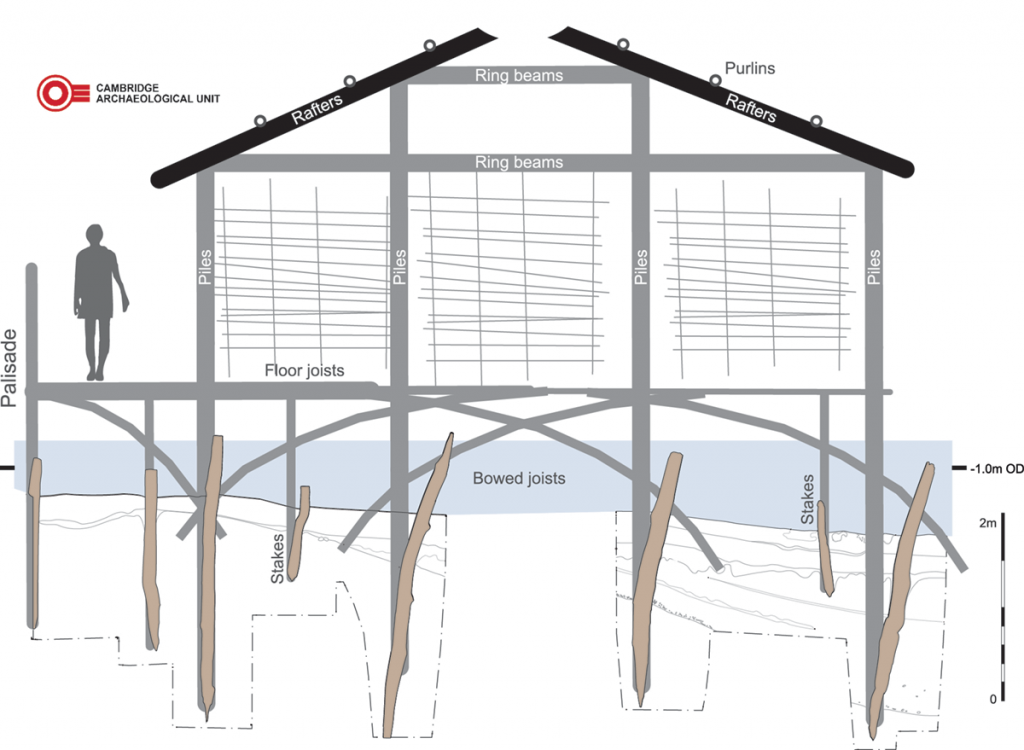
Lifespan
The post-excavation analysis of Must Farm has revealed that the settlement was short-lived, burning down only nine months to a year after construction started. Examination of the structural wood found that much of the timber was unseasoned, demonstrating that the fire had occurred relatively shortly after it had been cut down and used in the building of the settlement. Similarly, there was a lack of synanthropes, organisms associated with human habitation such as wood boring beetles, providing further evidence the fire happened before these creatures could move in. Finally, studies of the quantities of rubbish from the site show the volumes indicate a short-lived occupation.
Cause of the Fire
What caused the fire that destroyed the site? While study and analysis has helped archaeologists better understand the fire itself and how it likely took hold and destroyed the roundhouses, it hasn’t been possible to establish the circumstances of the fire.
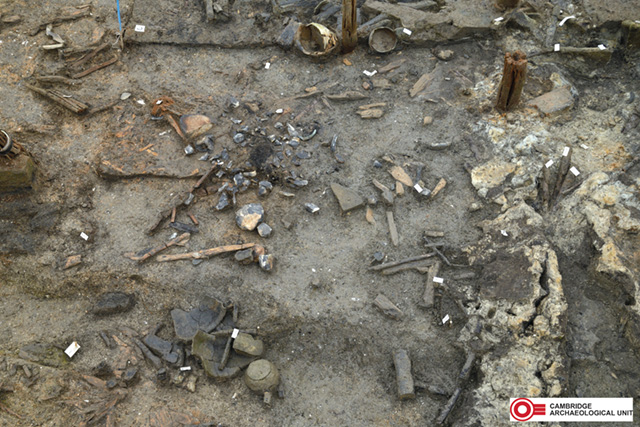
There are a range of potential circumstances surrounding the blaze and further analysis has highlighted several different scenarios. The stilted roundhouses were built very close together, their roofs touching, or almost touching. If a fire took hold in one of the buildings, it would spread very quickly between the structures and could have easily caused the destruction of the settlement. One potential cause was an accident with an internal fire that quickly spiralled out-of-control.
Alternatively, the presence of weapons, such as swords and spears, and shields during the Late Bronze Age suggests that conflict was an aspect of society at this time. Swords and spears were found at Must Farm, the settlement was built in a defensible location over water with a palisade of sharpened stakes surrounding it. Could it be that the settlement was burnt down in an act of aggression? However, a lack of human remains from the site suggests none of its occupants died during the fire, could they have been driven away?
Ultimately, despite the incredible preservation at Must Farm, the cause of the site’s destruction is likely to remain elusive.
The Must Farm Pile-Dwelling Settlement
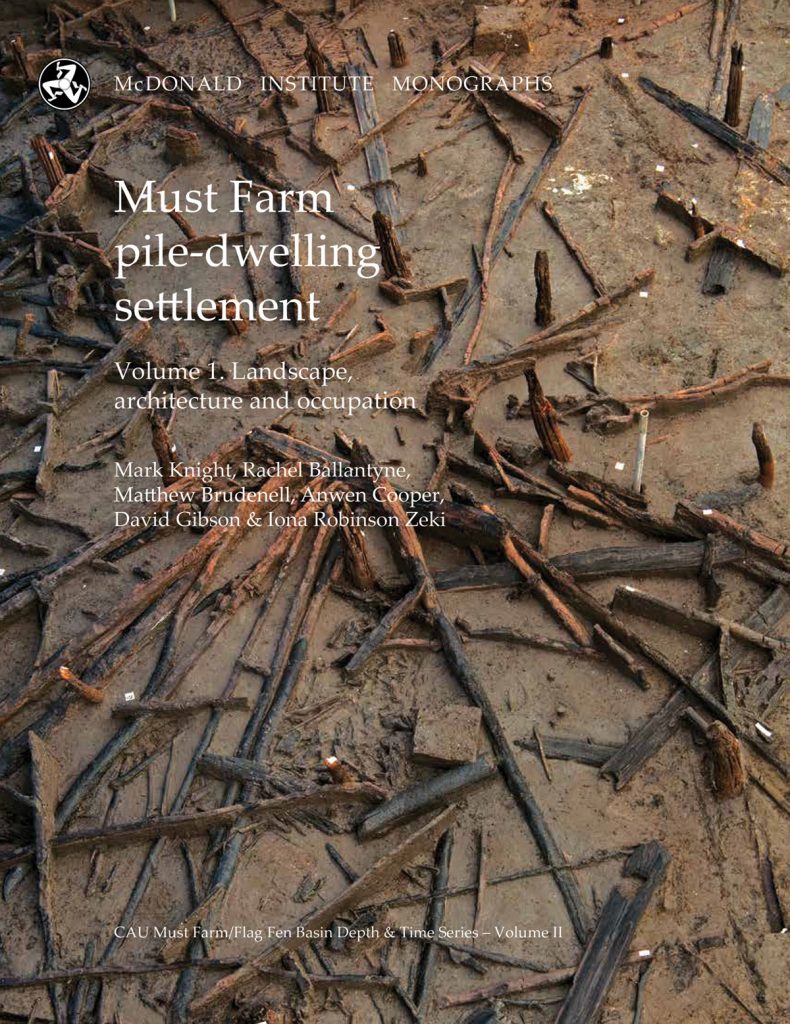
Read more about the Must Farm settlement in the Open Access publication
The Must Farm pile-dwelling settlement has proved to be one of the most fascinating prehistoric sites to be discovered in the UK in recent memory. Despite these being the only stilted roundhouses from this period currently known in the UK, they were unlikely to have been unique. The buildings’ architecture suggests that the people that built these dwellings had done so before and knew what they were doing. With excavations rarely going to the depths encountered at Must Farm, there is every possibility that the remains of more of these settlements are buried across Fenland, waiting for archaeologists to find them.
Similarly, the site contains the most comprehensive domestic assemblage of Late Bronze Age material complete with an incredible range of metalwork, textiles, pottery and wooden artefacts. What is most exciting about these household inventories is that they seem to represent the typical contents of a Bronze Age home. It is this reflection of the everyday that is so thrilling for archaeologists as while the settlement’s preservation may be exceptional, its contents were far from being so. The possessions recovered were the routine, day-in, day-out objects the people living at the site were using regularly, making Must Farm an incredible opportunity to explore the everyday life of a Fenland community from 850BC.
Learn more
Publications
Read the Open Access publications the Must Farm pile-dwelling settlement: Volume 1. Landscape, architecture and occupation and Volume 2. Specialist reports.Diaries
Read the Dig Diaries and Post-Ex Diaries from the 2015-16 excavations at the pile-dwelling settlement.Discoveries
See some of the discoveries from the Must Farm pile-dwelling settlement.
Making Must Farm
Find out about our work with AncientCraft recreating Must Farm’s material.
FAQs
Further information on the Must Farm project.

